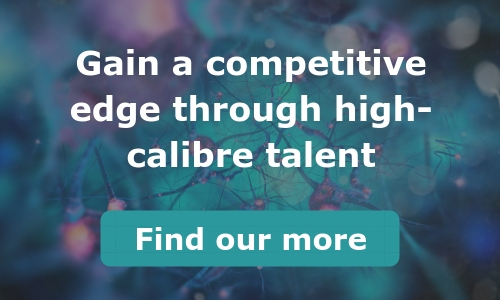The Life Science industry is renowned for its workplace health and employee well-being initiatives. These programs address important elements such as employee development, engagement, job satisfaction, organisational leadership, values, mental health, and work-life balance, as well as promoting active and healthy lifestyle choices, both inside and outside of the workplace.
Productivity Vs. Efficiency
One of the motivators behind corporate attention to employee well-being is the growing awareness of the difference between productivity and efficiency.
- Productivity is a measure of the amount of work accomplished in a specific period, such as a typical workday.
- Efficiency measures the quality of employee output. An employee can be productive without being efficient.
Under ideal circumstances, employees are productive and efficient, but this balance is often compromised by poor health and employee well-being. This phenomenon is known as presenteeism: the person is physically at their desk but not being productive. The estimated cost associated with presenteeism is up to three times more expensive than the equivalent direct health care expenses.
Research suggests that not only do well-being programmes enhance productivity, they can also reduce company costs by an average of $1600 per person, thanks to fewer sick days. This grows considerably for Executive and C-Suite roles. To reap the benefits of having a healthy and happy workforce, consider implementing these 7 employee well-being initiatives:
- Understand Employee Needs
- Create Opportunities for Employees to Excel
- Provide Flexible Work Arrangements
- Invest in Emotional Intelligence Training
- Increase Access to Nutritious Foods
- Recognise Hard Work
- Develop Corporate Social Responsibility Programs
Keep reading as we fully explore what these initiatives entail.
Understand Employee Needs
Maslow’s hierarchy of needs is a great starting point for employers who want to improve engagement and productivity levels in their function or unit. It states that people are motivated when certain needs are satisfied in a hierarchical order. At the bottom is physical survival, followed by safety, love and belonging, esteem, and finally the pinnacle, which is self-actualisation.
Here’s what this concept might look like in the workplace:
- Physiological: Employees need a comfortable environment in which to work. This can be maintained by controlling the office environment (e.g. heating, lighting, layout).
- Safety: A safe workplace means job security, a secure building, and even ergonomic furniture such as standing desks and adjustable chairs.
- Love and Belonging: Employees need to feel as if they belong. Organisations that host social and team-building activities have employees that are more engaged than those that don’t.
- Esteem: Employees want to feel that their contributions are recognised. If an employee is confident that their accomplishments are recognised, they’ll be happier and more productive.
- Self-actualisation: In workplace terms, self-actualisation refers to maximising one’s true potential. Employees should be put in positions that match their strengths. Any workforce that has collectively reached this level is healthy, fully engaged, and productive. To appear in Fortune magazine’s Top 100 Best Companies to Work For, a company must attain level five.
To cultivate a productive workforce, company owners and managers need to understand what motivates their employees and use that knowledge to heighten engagement.
Create Opportunities for Employees to Excel
Employees want to see a clear path for career progression. Providing access to a career roadmap and the right opportunities to excel can immediately improve engagement and employee well-being.
Research shows that organisations who effectively match employees with responsibilities which align with their personal interests gain two vital benefits:
- Retention of top talent
- Improved employee productivity and efficiency
To increase engagement, set goals and then provide feedback on their performance. Professional development opportunities are an excellent way to ensure employees continue to learn and grow. Investment in their professional futures is both a form of praise and sign of recognition; two elements that today’s workforce value.
Provide Flexible Work Arrangements
Not every job can be completed effectively from home — but for those that can, you should find a major productivity boost. Working from home just one day a week gives employees a break from their daily commute and workplace distractions. According to Robert Half, nearly 60% of HR Directors reported an increase in productivity when employees had the option of remote working. This is because:
- Workers want to justify a flexible working arrangement, so they apply themselves even more to deliver results
- They see flexible hours as confirmation that they are valued by their employer
- They enjoy their jobs more due to an improved work-life balance
Flexible working can also encourage greater creativity and innovation, with impressive results that benefit both the employee and employer.
Invest in Emotional Intelligence Training
Emotional intelligence is the ability to understand and analyse emotional information. Being aware of your emotions makes it easier to understand your needs, and the needs of others. Ultimately, this results in better decision-making and workplace relationships.
According to Entrepreneur.com, emotional intelligence (EQ) can factor strongly in an employee’s success at their job. Emotions are strong, can be difficult to manage, and may consequently impact performance. Those with higher EQ scores have more self-control and get along more easily with others. They also tend to persevere when the going gets tough. These are all qualities that set a person up for success in the corporate world.
Emotional intelligence developmental training can improve an employee’s initiative. Emotional responses often take on lives of their own and left to fester, can inspire self-defeating reactions such as resentment and hostility. Dedicated training can halt these unwanted interpretations and behaviours, allowing an employee to remain in control of their impulses while becoming more patient and empathetic with supervisors and co-workers alike. The outcome can be greater productivity due to better collaboration and focus on the task at hand.
Increase Access to Nutritious Food
Compared with the 1970s, people work an estimated 200 more hours per year, and practically everyone eats during working hours. Full-time employees consume at least one in four meals at their desk or during office hours. What’s concerning is that meals eaten away from home tend to be less healthy choices, which is arguably one of the contributors to today’s obesity problem.
Eating a nutritionally-poor diet during the work day has been connected to the following issues:
- Frequent Illness
- Greater Fatigue
- Difficulty making decisions
- Poorer concentration
- Low morale
In contrast, access to healthy meals and snacks has been associated with a 25% increase in job satisfaction and an improved perception of job performance rating.
Recognise Hard Work
One of the biggest killers of morale and productivity is failing to recognise an employee’s hard work. If your team feel unappreciated, then they’ll quickly switch off and stop putting in as much effort. This is the last thing you want, as poor morale can quickly spread throughout your company dealing extensive damage to your productivity.
Ensuring you pay your team well also makes it less likely for them to leave. With the growing cost of living crisis, failing to pay your employees well will only ensure they leave as soon as a higher paying job comes along. Offering pay-rises and bonuses to employees in exchange for hard work is an excellent way of making your team feel valued.
You can also champion your hardest working employees. By positioning hard-working members as role models, you can more easily develop a positive environment that supports employee well-being.
Develop Corporate Social Responsibility Programs
Organisations with recognised social responsibility programmes not only improve the perception of their brand but increase employee engagement. Millennials in particular actively seek employers that make valuable contributions to social and charitable causes. When employees have the opportunity to engage in such causes, a sense of purpose underscores their career success and growth. Greater pride in work can translate into higher levels of productivity and efficiency, as well as increased loyalty and a better sense of self-actualisation.
Analysing Responses
Once employee well-being initiatives are implemented, what’s the best way to measure efficacy?
- Ask employees for feedback. Companies that cultivate an open and honest culture can simply ask employees what they think about the new measures.
- Participation and usage data. Examples of wellness metrics include the number of employees that use the initiatives and how often they partake in them.
- Monitor sick days. Has there been a difference in the number of sick days used? A reduction would suggest the initiative is making a difference.
- Review work quality. Are the employees consistently turning in better work? When productivity and efficiency work hand in hand, the outcome is noticeable.
The well-being of any organisation starts with its workforce. Companies that devote time and resources towards initiatives that support employee well-being will develop a competitive advantage over those that do not. The results can be seen in terms of productivity, quality of work, and can give the organisation more appeal to the brightest talent in the marketplace.
For more hiring advice tailored to hiring managers in the life science industry…
- Read 9 Hiring Metrics To Focus On In Your Life Science Recruitment Strategy.
- View our talent solutions to see how we can help you gain a competitive edge through talent.
* Fraser Dove International is a talent consultancy operating exclusively across the life sciences industry. While our roots lie in executive search, we provide more than the traditional recruitment services. Uniquely placed within the market, we have been providing cutting-edge talent solutions and insight to organisations at all stages of their journey – from start-up to established leaders – since 2013.

 Estimated read time: 5 mins
Estimated read time: 5 mins Date posted:28/11/2018
Date posted:28/11/2018





